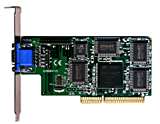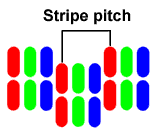
Jaton Video-78AGP 3D Graphics Card
Review date: 3 February 1999.Last modified 03-Dec-2011.
What do you do these days if you want to upgrade an old graphics card, and you might want to play a 3D game or two, but you can't justify spending hundreds of dollars on a hot new Riva TNT board (like the Diamond Viper V550, reviewed here) or Voodoo Banshee (like the Diamond Monster Fusion, reviewed here)?
You buy a mid-range card, that's what. Something that supports decent resolutions and refresh rates, and has reasonable 3D performance so you can have fun with Quake, but which costs around a third of the price of the cutting-edge cards.
One such is Jaton's Video-78AGP 3D, an 8Mb 2D/3D board based on nVidia's older Riva 128ZX chipset. It sells for less than $115 (Australian dollars), and it's good value.
What you get
In common with most cheap video cards, this is not a luxury package. One card, one don't-sneeze-or-you'll-lose-it manual, one software CD. That's it. There is a bundled game, included on the disc - Sega Virtua Fighter 2, another of the elderly Sega efforts that Jaton throw around with gay abandon.
Also in common with many cheap cards, the Video-78AGP lacks a heat sink on its main graphics processor. Modern 3D accelerators run rather hot, and many PC cases have lousy ventilation, so it's quite possible that users in warmer climes (like Australia, where I am) with dodgy little single-fan mini-tower or desktop cases will have problems with this card on warmer days. If your computer room is always cool and/or your case is well ventilated, don't worry about this - or try adapting my advice for adding a fan to a Viper V550, here. This should only be a serious problem if you decide to try overclocking the card (see EnTech's web page for The Powerstrip utility to do this).
Setting up
As the name suggests, this is an AGP (Advanced Graphics Port) card, which means you need an AGP slot to put it in. As a recent correspondent reminded me, just having a computer that says it has "AGP video" does not mean you actually have an AGP slot; Compaq Presario models with AGP video actually have the video "card" built into the motherboard, and have no AGP slot. Yay Compaq.
Assuming you do have an AGP slot, and you're upgrading from a PCI video card, you should switch to a plain VGA driver (the very first option in Windows' huge list of video drivers) before removing your old card. If you're running Windows 95, you need Windows 95 OSR2 - the Release B version that came between 95 and 98, but was never released as a retail product, only with PCs. The Other\Updates directory on your OSR2 CD should contain a file called usbsup.exe, which will install USB/AGP support.
After the USB/AGP stuff is set up and the card is installed, there's likely to still be a silly message in the Device Manager about a conflict with the PCI bridge, but you can ignore it. Everything will work.
USB support is automatically included in Windows 98. Windows NT users don't need USB drivers, which is good, because at present none exist.
Performance
A lot of low-cost computers come with Riva 128ZX-based graphics cards, because they give an excellent account of themselves for the money. The 128ZX is the evolved version of the older 128, the chief difference being 8Mb of video memory, for support of higher resolutions and a big 3D texture memory boost. The ZX version has a 250MHz RAMDAC - the processor that converts the image from digital to analogue form so it can be sent to the monitor. The old one ran at 230MHz, the new one runs at 250MHz, and the difference in performance is slight.
For most people's purposes, the output resolutions and refresh rates from the 78AGP are more than adequate. Its top resolution is 1920 by 1200 in 16 bit colour at 75Hz, but it'll do 1024 by 768 in 32 bit at an 85Hz refresh rate, no worries. The standard Jaton driver tops out at 1600 by 1200, but that's plenty for most users; if you really want to use the higher resolution mode, try playing with the drivers for other 128ZX boards. Since a monitor that can clearly display this resolution costs something like 20 times as much as the graphics card, I don't think many users will care; see here for more information on this.
Like every other graphics card on the market today, the 78AGP is more than fast enough for every ordinary 2D rendering application. If you're running business apps and playing games that don't support 3D acceleration, pretty much any video card on the computer store shelf will do you proud. The 78AGP's 2D statistics are not as impressive as those form the latest supercards, but it's still faster than you need it to be.
The 128ZX chipset supports multipass rendering and so isn't unexpectedly slow in games which use multipass, like Quake 2 and Unreal. It also supports OpenGL and so can be used with pretty much any game that supports 3D acceleration; only those that demand the 3Dfx Glide API or the rare cases that support Direct3D but not OpenGL will be a problem.
In 3D, the 128ZX can broadly be thought of as slightly better than a Voodoo Graphics (Voodoo 1) board. In 640 by 480 resolution - the same as the maximum Z-buffered resolution of the Voodoo Graphics - it outperforms the Voodoo board by a tiny margin on Pentium class computers and up to 25%, depending on the phase of the moon and the power of the processor, on Pentium-II class machines. If you jump up to 800 by 600, your frame rates will generally be worse than those a Voodoo Graphics board would deliver in 640 by 480 - but if you're playing flight simulators or other games that don't push many polygons around, the frame rate may still be more than high enough. At least you can try. The extra 4Mb of memory offered by the ZX version of the chipset even lets you try 1024 by 768, if you're game.
The extra memory also helps performance noticeably in games that use a lot of textures, with the improvement dropping to about 5% in games like Quake 2, which generally aren't that demanding. Like many AGP cards, the 128ZX doesn't actually use the fancy AGP texturing feature which allows system memory, as opposed to video card memory, to be used for texture storage. This gives lots of texture memory, but it's lots of slow texture memory; even at the 66MHz of the AGP 2X bus used by the Video-78 (twice as fast as PCI), texturing from local (video card) memory is much faster than using system RAM.
If you play a game that has more textures than the video card's onboard memory can hold - quite possible with a mere 4Mb card - a card that supports AGP texturing will perform better than a card that doesn't, while the textures are being thrashed around. Neither card will perform very well, though. The 8Mb of video memory used by the 128ZX is perfectly adequate for all current games. The 66MHz AGP bus by itself gives only a very slight performance increase over PCI.
The chief problem with the Riva 128 chipsets for 3D is not performance, but image quality. Your games just won't be as pretty with a Riva 128 as with, say, a Riva TNT; edges will look jaggier, and you'll see the occasional "crack" - polygons that don't meet quite right. This in no way spoils the fun; games are still perfectly playable, and more than fast enough in 640 by 480 mode with any recent processor - but it's clear that this card is not the connoisseur's choice.
Overall
If you don't want to shell out for a cutting-edge card, this is by no means a lousy alternative. For the money, it delivers fast 2D and fast enough 3D for most gamers. For less than $115 (Australian dollars), you really can't complain.




